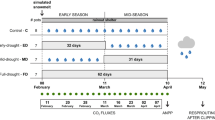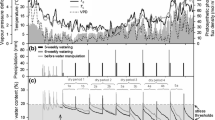Abstract
It is not clear if tree canopies in savanna ecosystems exert positive or negative effects on soil moisture, and how these might affect understory plant carbon balance. To address this, we quantified rooting-zone volumetric soil moisture (θ25 cm), plant size, leaf-level and whole-plant gas exchange of the bunchgrass, bush muhly (Muhlenbergia porteri), growing under and between mesquite (Prosopis velutina) in a southwestern US savanna. Across two contrasting monsoon seasons, bare soil θ25 cm was 1.0–2.5% lower in understory than in the intercanopy, and was consistently higher than in soils under grasses, where θ25 cm was similar between locations. Understory plants had smaller canopy areas and volumes with larger basal diameters than intercanopy plants. During an above-average monsoon, intercanopy and understory plants had similar seasonal light-saturated leaf-level photosynthesis (A net-sat), stomatal conductance (g s-sat), and whole-plant aboveground respiration (R auto), but with higher whole-plant photosynthesis (GEPplant) and transpiration (T plant) in intercanopy plants. During a below-average monsoon, intercanopy plants had higher diurnally integrated GEPplant, R auto, and T plant. These findings showed little evidence of strong, direct positive canopy effects to soil moisture and attendant plant performance. Rather, it seems understory conditions foster competitive dominance by drought-tolerant species, and that positive and negative canopy effects on soil moisture and community and ecosystem processes depends on a suite of interacting biotic and abiotic factors.






Similar content being viewed by others
References
Adams DK, Comrie AC (1997) The North American monsoon. Bull Am Meteorol Soc 78:2197–2213
Anderson JE, Toft NL (1993) Depletion of soil moisture by two cold desert bunchgrasses and effects on photosynthetic performance. Great Basin Nat 53:97–106
Belsky AJ, Amundson RG, Duxbury JM, Riha SJ, Ali AR, Mwonga SM (1989) The effect of trees on their physical, chemical, and biological environments in a semi-arid savanna in Kenya. J Appl Ecol 6:1005–1024
Bhark EW, Small EE (2003) Association between plant canopies and the spatial patterns of infiltration in shrubland and grassland of the Chihuahuan Desert, New Mexico. Ecosystems 6:185–196
Breckenfeld DJ, Robinett D (2003) Soil and ecological sites of the Santa Rita Experimental Range. In: McClaran MP, Ffolliott PF, Edminster CB (eds) Santa Rita Experimental Range: 100 years (1903 to 2003) of accomplishments and contributions, conference proceedings Oct 30–Nov 1, 2003, Tucson AZ, vol 30. USDA Rocky Mountain Research Station Proceedings, USDA Forest Service Rocky Mountain Research Station, Ogden, UT, pp 157–165
Breshears DD, Rich PM, Barnes FJ, Campbell K (1997) Overstory-imposed heterogeneity in solar radiation and soil moisture in a semiarid woodland. Ecol Appl 7:1201–1215
Brittingham S, Walker LR (2000) Facilitation of Yucca brevifolia recruitment by Mojave Desert shrubs. West North Am Nat 60:374–383
Cable DR (1975) Influence of precipitation on perennial grass production in the semidesert southwest. Ecology 56:981–986
Cable DR (1977) Seasonal use of soil water by native velvet mesquite. J Range Manage 30:4–11
Caldwell MM, Dean TJ, Nowak RS, Dzurec RS, Richards JH (1983) Bunchgrass architecture, light interception and water-use efficiency: assessment by fiber optic point quadrats and gas exchange. Oecologia 59:178–184
Carlyle-Moses DE (2004) Throughfall, stemflow, and canopy interception loss fluxes in a semi-arid Sierra Madre Oriental mattoral community. J Arid Environ 58:181–202
Casper BB, Schenck JH, Jackson RB (2003) Defining a plant’s belowground zone of influence. Ecology 84:2313–2321
Caylor KK, Rodriguez-Iturbe I (2004) Coupling ecohydrological patterns and processes in semi-arid landscapes. In: Webb B (ed) Proceedings of the British Hydrological Society’s International Conference on Hydrology: Science and Practice for the 21st century, vol 2. British Hydrological Society, Imperial College, London, UK, pp 39–47
Caylor KK, Shugart HH, Dowty PR, Smith TM (2003) Tree spacing along the Kalahari transect in southern Africa. J Arid Environ 54:281–296
Caylor KK, Dowty PR, Shugart HH, Ringrose S (2004) Relationship between small-scale structural variability and simulated vegetation productivity across a regional moisture gradient in southern Africa. Glob Chang Biol 10:374–382
Caylor KK, Shugart HH, Rodriguez-Iturbe I (2005) Tree canopy effects on simulated water stress in Southern African savannas. Ecosystems 8:17–32. doi:10.1007/s10021-004-0027-9
Chan KY (2006) Bulk Density. In: Lal R (ed) Encyclopedia of soil science. CRC Press, Boca Raton, pp 191–193
D’Odorico P, Caylor K, Okin GS, Scanlon TM (2007) On soil moisture-vegetation feedbacks and their possible effects on the dynamics of dryland ecosystems. J Geophys Res 112:G04010. doi:10.1029/2006JG000379
Devitt DA, Smith SD (2002) Root-channel macropores enhance downward movement of water in the Mojave Desert ecosystem. J Arid Environ 50:99–108
Emmerich WE, Verdugo CL (2008) Precipitation thresholds for CO2 uptake in grass and shrub communities on Walnut Gulch Experimental Watershed. Water Resource Res 44:W05S16. doi:10.1029/2006WR005690
Evanari M, Shanan L, Tadmor N (1982) The Negev: the challenge of the desert. Harvard University Press, Cambridge, p 437
Fernandez RJ, Reynolds JF (2000) Potential growth and drought tolerance of eight desert grasses: lack of a trade-off? Oecologia 123:90–98
Fernandez ME, Gyenge JE, Salada GD, Schlichter TM (2002) Silvopastoral systems in northwestern Patagonia I: growth and photosynthesis of Stipa speciosa under different levels of Pinus ponderosa cover. Agrofor Syst 55:27–35
Flanagan LB, Johnson BG (2005) Interacting effects of temperature, soil moisture and plant biomass on ecosystem respiration in a northern temperate grassland. Agric For Meteorol 130:237–253
Franco AC, Nobel PS (1989) Effect of nurse plants on the microhabitat and growth of cacti. J Ecol 77:870–886
Garduño HR, Fernald AG, Cibils AF, VanLeeuwen DM (2009) Response of understory vegetation and soil moisture to infrequent heavy defoliation of chemically thinned juniper woodland. J Arid Environ. doi:10.1016/j.jaridenv.2009.08.005
Gibbens RP, Lenz JM (2001) Root systems of some Chihuahuan Desert plants. J Arid Environ 49:221–263
Greene RSB, Kinnell PIA, Wood JT (1994) Role of plant cover and stock trampling on runoff and soil erosion from semiarid wooded rangelands. Aust J Soil Res 32:953–973
Hamerlynck EP, McAuliffe JR, McDonald EV, Smith SD (2002) Ecological responses of two Mojave Desert shrubs to soil horizon development and soil water dynamics. Ecology 83:768–779
Hochstrasser T, Peters DPC (2004) Subdominant species distribution in microsites around two life forms at a desert grassland–shrubland transition zone. J Veg Sci 15:615–622
Holzapfel C, Tielbörger K, Parag HA, Kigel J, Sternberg M (2006) Annual plant–shrub interactions along an aridity gradient. Basic Appl Ecol 7:268–279
Huxman TE, Cable JM, Ignace DD, Eilts JA, English NB, Weltzin J, Williams DG (2004) Response of net ecosystem gas exchange to a simulated precipitation pulse in a semi-arid grassland: the role of native versus non-native grasses and soil texture. Oecologia 141:295–305
Jenerette GD, Scott RL, Huxman TE (2008) Whole ecosystem metabolic pulses following precipitation events. Funct Ecol 22:924–930
Lejeune O, Tlidi M, Couteron P (2002) Localized vegetation patches: a self-organized response to resource scarcity. Phys Rev E 66:010901. doi:101103/PhysRevE.66.010901
Livingstone M, Roundy BA, Smith SE (1997) Association of overstory plant canopies and native grasses in southern Arizona. J Arid Environ 35:441–449
Loik ME, Breshears DD, Lauenroth WK, Belnap J (2004) A multi-scale perspective of water pulses in dryland ecosystems: climatology and ecohydrology of the western USA. Oecologia 141:268–281
McAuliffe JR (1986) Herbivore-limited establishment of a Sonoran Desert tree, Cercidium microphyllum. Ecology 67:276–280
McAuliffe JR (1994) Landscape evolution, soil formation, and ecological patterns and processes in Sonoran Desert bajadas. Ecol Monogr 64:111–148
McAuliffe JR, McDonald EV (2006) Holocene environmental change and vegetation contraction in the Sonoran Desert. Quat Res 65:204–215
McAuliffe JR, Hamerlynck EP, Eppes M (2007) Landscape dynamics fostering the development and persistence of long-lived creosotebush (Larrea tridentata) clones in the Mojave Desert. J Arid Environ 69:96–126
McClaran MP (2003) A century of vegetation change on the Santa Rita Experimental Range. In: McClaran MP, Ffolliott PF, Edminster CB (eds) Proceedings Rocky Mountain Research Station, Ogden, UT, pp 16–33
McClaran MP, Angell DL (2007) Mesquite and grass relationships at two spatial resolutions. Plant Ecol 191:119–126
McClaran MP, Bartolome JW (1989) Effects of Quercus douglasii (Fagaceae) on herbaceous understory along a rainfall gradient. Madrono 36:141–153
McKee TB, Doesken NJ, Kleist J (1993) The relationship of drought frequency and duration to time scale. In: Proceedings of the eighth conference on applied climatology. American Meteorological Society, Boston, MA, pp 179–184
Noy-Meir I (1973) Desert ecosystems: environments and producers. Annu Rev Ecol Syst 4:25–51
Potts DL, Huxman TE, Cable JM, English NB, Ignace DD, Eilts JA, Mason MJ, Weltzin JF, Williams DG (2006) Antecedent moisture and seasonal precipitation influence the response of canopy-scale carbon and water exchange to rainfall pulses in a semi-arid grassland. New Phytol 170:849–860
Prider JN, Facelli JM (2004) Interactive effects of drought and shade on three arid zone chenopod shrubs with contrasting distributions in relation to tree canopies. Funct Ecol 18:67–76
Pugnaire FI, Cristina A, Valladares F (2004) Soil as a mediator in plant–plant interactions in a semi-arid plant community. J Veg Sci 15:85–92
Riginos C (2009) Grass competition suppresses savanna tree growth across multiple demographic stages. Ecology 90:335–340
Ruyle GB (2003) Rangeland livestock production: developing the concept of sustainability on the Santa Rita Experimental Range. In: McClaran MP, Ffolliott PF, Edminster CB (eds) Santa Rita experimental range: 100 years (1903 to 2003) of accomplishments and contributions, conference proceedings Oct 30–Nov 1, 2003, Tucson AZ. USDA Rocky Mountain Research Station Proceedings, vol 30. USDA Forest Service Rocky Mountain Research Station, Ogden UT, pp 34–47
Saleska SR, Harte JN, Torn MS (1999) The effect of experimental ecosystem warming on CO2 fluxes in a montane meadow. Glob Chang Biol 5:125–141
Scanlon TM, Caylor KK, Levin SA, Rodriguez-Iturbe I (2007) Positive feedbacks promote power-clustering of Kalahari vegetation. Nature 449:209–212. doi:10.1038/nature06060
Scholes RJ, Archer SR (1997) Tree–grass interactions in savannas. Annu Rev Ecol Syst 28:517–544
Scott RL, Cable WL, Hultine KR (2008) The ecohydrologic significance of hydraulic redistribution in a semiarid savanna. Water Resourc Res 44:W02440. doi:10.1029/2007WR006149
Scott RL, Jenerette GD, Potts DL, Huxman TE (2009) Effects of seasonal drought on net carbon dioxide exchange from a woody-plant-encroached semiarid grassland. J Geophys Res 114:G04004. doi:10.1029/2008JG000900
Simmons MT, Archer SR, Teague WR, Ansley RJ (2008) Tree (Prosopis glandulosa) effects on grass growth: an experimental assessment of above- and belowground interactions in a temperate savanna. J Arid Environ 72:314–325
Smith SD, Monson RK, Anderson JE (1997) Physiological ecology of North American desert plants. Springer, Berlin
Sponseller RA (2007) Precipitation pulses and soil CO2 flux in a Sonoran Desert ecosystem. Glob Chang Biol 13:426–436
Suzan H, Nabhan GP, Patten DT (1996) The importance of Olneya testosa as a nurse plant in the Sonoran Desert. J Veg Sci 7:635–644
Tiedemann AR, Klemmedson JO (2004) Responses of desert grassland vegetation to mesquite removal and regrowth. J Range Manage 57:455–465
Tielbörger K, Kadmon R (2000) Temporal environmental variation tips balance between facilitation and interference in desert plants. Ecology 81:1544–1553
Titus JH, Nowak RS, Smith SD (2002) Soil resource heterogeneity in the Mojave Desert. J Arid Environ 52:269–292
Turner RM, Alcorn SM, Olin G, Booth JA (1966) The influence of shade, soil, and water on saguaro seedling establishment. Bot Gaz 127:95–102
Walker BH, Ludwig D, Holling CS, Peterman RM (1981) Stability of semiarid savanna grazing systems. J Ecol 69:473–498
Yoder CK, Nowak RS (1999) Soil moisture extraction by evergreen and drought-deciduous shrubs in the Mojave Desert during wet and dry years. J Arid Environ 42:81–96
Zar JH (1974) Biostatistical analysis. Prentice-Hall, Englewood Cliffs, NJ
Acknowledgments
We thank T.O. Keefer for helping test and install the TDR station, and Michelle Cavanaugh, Ashley Wiede, J.J. Dale, Evan Sommer, Maggie Heard and Donna King for their help in the field, and support from the Philecology Foundation to T. Huxman.
Author information
Authors and Affiliations
Corresponding author
Additional information
Communicated by Kouki Hikosaka.
Rights and permissions
About this article
Cite this article
Hamerlynck, E.P., Scott, R.L., Susan Moran, M. et al. Inter- and under-canopy soil water, leaf-level and whole-plant gas exchange dynamics of a semi-arid perennial C4 grass. Oecologia 165, 17–29 (2011). https://doi.org/10.1007/s00442-010-1757-3
Received:
Accepted:
Published:
Issue Date:
DOI: https://doi.org/10.1007/s00442-010-1757-3




